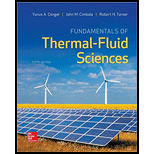
a)
The final temperature in each tank A and tank B.
a)
Explanation of Solution
Given:
The volume of the tank A
The pressure of the tank A
The quality of the tank A
The mass of the tank B
The pressure of the tank
The temperature of the tank
The pressure of the tank A after the mixture is 200 kPa.
The heat transfer to surrounding is
The surrounding temperature
Calculation:
Refer Table A-5, “Saturated water-Pressure table”, obtain the following properties of water at initial pressure
Calculate the specific volume
Calculate the specific internal energy of steam from tables
Write the formula to calculate the specific entropy of steam from tables
Refer Table A-5, “Saturated water-Pressure table”, obtain the following properties of water at final pressure
Here, final temperature of steam in tank A is
The steam in tank A undergoes isentropic process, Thus, the final specific entropy of steam in tank A
Substitute
Substitute
Substitute
Refer Table A-6, “Superheated water”, note the properties for steam in tank B initially at the pressure of
Calculate the mass of the steam
Calculate the final mass of steam in tank A
Write the expression for the mass balance.
Here, mass of the water entering into the system is
Substitute
Rewrite the Equation (V) to calculate the final total mass of steam in tank B
Substitute
Substitute
Write the expression for the energy balance Equation for a closed system.
Here, net energy transfer into the control volume is
From first law of thermodynamics, Re-write the Equation (VII) for heat transfer
Refer Table A-5, “Saturated water-Temperature table”, obtain the following properties of water at
Here, the temperature of the steam in tank at final state is
Thus, the final temperature of steam in tank A is
b)
The entropy generated during the process.
b)
Explanation of Solution
Write the expression for the entropy balance Equation of the system.
Here, rate of net entropy in is
Re-write the Equation (VIII) to obtain the entropy generated
Thus, the entropy generated during this process is
Want to see more full solutions like this?
Chapter 8 Solutions
Fundamentals of Thermal-Fluid Sciences
 Elements Of ElectromagneticsMechanical EngineeringISBN:9780190698614Author:Sadiku, Matthew N. O.Publisher:Oxford University Press
Elements Of ElectromagneticsMechanical EngineeringISBN:9780190698614Author:Sadiku, Matthew N. O.Publisher:Oxford University Press Mechanics of Materials (10th Edition)Mechanical EngineeringISBN:9780134319650Author:Russell C. HibbelerPublisher:PEARSON
Mechanics of Materials (10th Edition)Mechanical EngineeringISBN:9780134319650Author:Russell C. HibbelerPublisher:PEARSON Thermodynamics: An Engineering ApproachMechanical EngineeringISBN:9781259822674Author:Yunus A. Cengel Dr., Michael A. BolesPublisher:McGraw-Hill Education
Thermodynamics: An Engineering ApproachMechanical EngineeringISBN:9781259822674Author:Yunus A. Cengel Dr., Michael A. BolesPublisher:McGraw-Hill Education Control Systems EngineeringMechanical EngineeringISBN:9781118170519Author:Norman S. NisePublisher:WILEY
Control Systems EngineeringMechanical EngineeringISBN:9781118170519Author:Norman S. NisePublisher:WILEY Mechanics of Materials (MindTap Course List)Mechanical EngineeringISBN:9781337093347Author:Barry J. Goodno, James M. GerePublisher:Cengage Learning
Mechanics of Materials (MindTap Course List)Mechanical EngineeringISBN:9781337093347Author:Barry J. Goodno, James M. GerePublisher:Cengage Learning Engineering Mechanics: StaticsMechanical EngineeringISBN:9781118807330Author:James L. Meriam, L. G. Kraige, J. N. BoltonPublisher:WILEY
Engineering Mechanics: StaticsMechanical EngineeringISBN:9781118807330Author:James L. Meriam, L. G. Kraige, J. N. BoltonPublisher:WILEY





